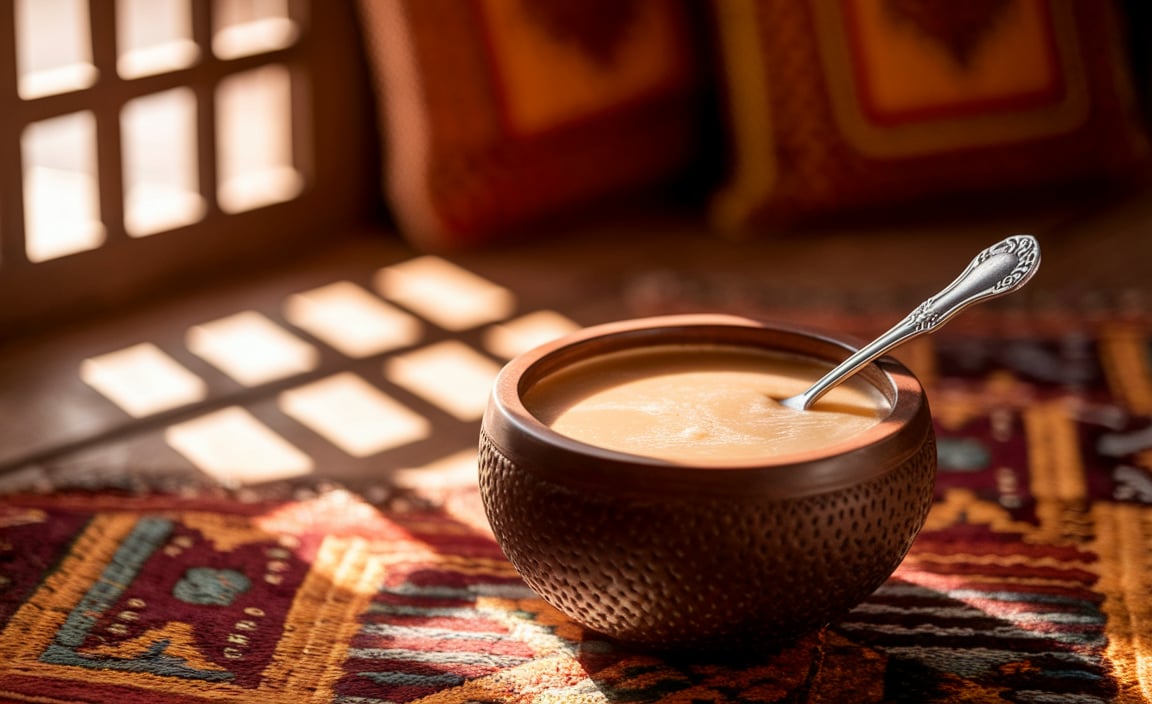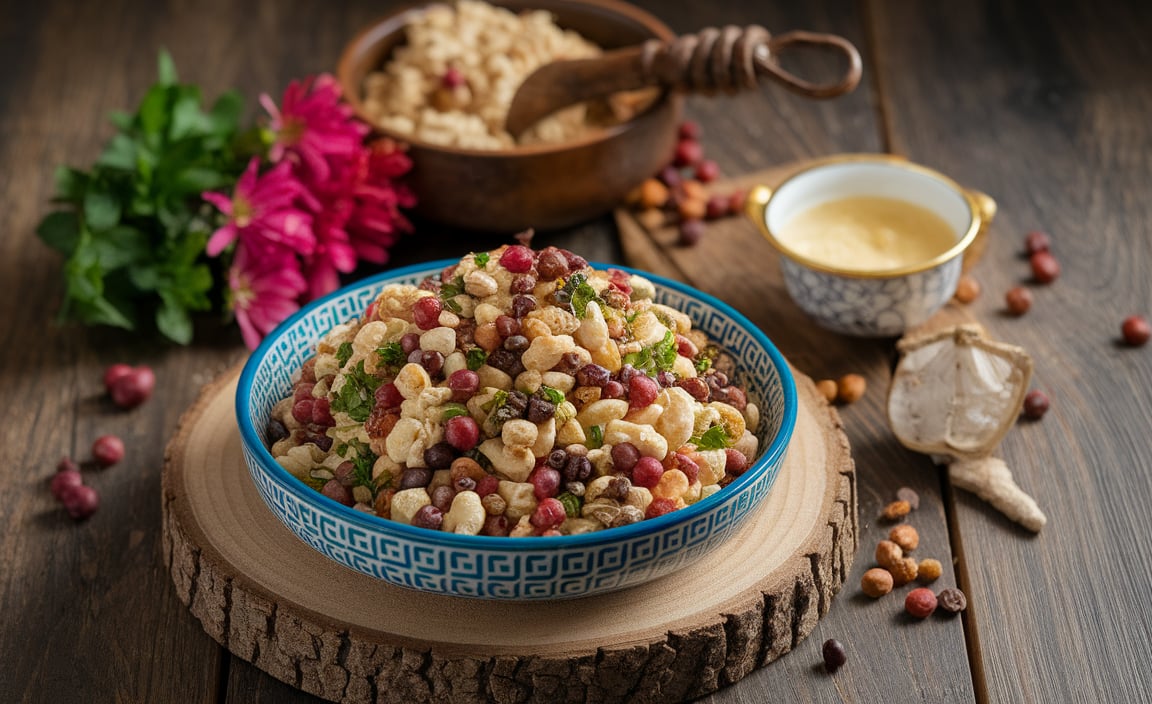Embark on a unique culinary adventure with Kazakh shubat tasting! Discover this fermented camel milk drink, a healthy and traditional beverage. Learn what shubat is, its taste profile, health benefits, and how to enjoy it like a local.
Welcome, fellow food adventurers! Ever wondered about those fascinating, lesser-known foods that tantalize taste buds around the globe? Today, we’re diving into the heart of Kazakhstan to explore a truly special drink: shubat! If you’re curious about unique flavors and have a taste for the extraordinary, you’re in for a treat. Many people hear about fermented dairy drinks, but shubat is in a league of its own. Don’t worry if you’ve never heard of it or aren’t sure how to approach it. We’ll guide you through everything you need to know to make your first shubat tasting a delightful and delicious discovery. Get ready to learn about its origins, its unique charm, and why it’s a must-try for any adventurous foodie!

What is Kazakh Shubat? A Traditional Camel Milk Delight

Shubat is a traditional fermented milk drink originating from the nomadic cultures of Central Asia, particularly Kazakhstan. It’s made from camel’s milk, which is left to ferment naturally, often using a starter culture from a previous batch. This process gives shubat its characteristic tangy flavor and effervescence. Unlike cow’s milk, camel milk is naturally lower in lactose and richer in vitamins and minerals, contributing to shubat’s unique nutritional profile and taste.
For centuries, nomadic peoples relied on shubat as a staple beverage. It was not only a source of hydration but also a vital source of nutrition, especially important during long journeys or harsh climates. The fermentation process not only preserved the milk but also made its nutrients more digestible. Its production is deeply intertwined with the pastoral lifestyle, celebrating the camel’s ability to thrive in arid environments and provide sustenance.
The word “shubat” itself likely comes from the Turkic word for “sour” or “fermented,” directly describing its nature. While historically a drink of necessity and sustenance, it has also become a cultural icon, representing Kazakh hospitality and tradition. Tasting shubat is more than just trying a new beverage; it’s a connection to a rich history and a resilient way of life.

The Sensory Experience: What Does Shubat Taste Like?
Approaching a new food or drink, especially one as unique as shubat, often begins with curiosity about its taste. Shubat offers a complex and intriguing flavor profile that sets it apart from more common fermented dairy products like yogurt or kefir. It’s an experience that engages multiple senses, from its aroma to its lingering finish.
The initial taste of shubat is often described as tangy and slightly sour, but not overwhelmingly so. This tartness comes from the lactic acid produced during fermentation. It’s a refreshing sourness, somewhat akin to a mild buttermilk or a less sweet yogurt drink. Unlike some fermented drinks, shubat typically doesn’t have a strong “gamey” or “funky” aftertaste, making it more accessible to a wider range of palates.
Texture-wise, shubat can vary. Freshly prepared shubat is often light and effervescent, with a gentle fizz that tingles on the tongue. This carbonation adds to its refreshing quality. As it ages or if prepared differently, it can become thicker, though it generally remains more liquid than yogurt. The consistency is usually smooth, and the fine bubbles contribute to a pleasant mouthfeel.
On the aroma front, expect a clean, lactic smell, sometimes with subtle hints of hay or pasture, reflecting the camel’s diet. It’s a natural, earthy scent that is far from pungent or unpleasant for those familiar with fermented foods.
The finish is typically clean and invigorating. The tanginess often gives way to a subtle sweetness or a mild, milky richness that leaves your palate refreshed. It’s a nuanced flavor that can evolve with each sip, making the tasting experience a discoverable journey.
Understanding the Flavor Profile
- Tanginess: A refreshing, mild sourness, similar to buttermilk or yogurt.
- Effervescence: Often has a light, tingly fizz, adding to its crispness.
- Aroma: Clean, lactic, and sometimes subtly earthy or grassy.
- Mouthfeel: Typically light and smooth, with a gentle carbonation.
- Finish: Refreshing and clean, with a subtle richness.
It’s important to note that the exact taste can depend on several factors: the specific camel herd’s diet, the fermentation time, the temperature, and the starter culture used. This variability is part of what makes tasting shubat an adventure – each batch can offer a slightly different experience.
The Health Benefits of Shubat

Beyond its unique taste, shubat is celebrated for its impressive health benefits, stemming from the nutrient-rich camel milk and the natural fermentation process. For centuries, it has been recognized not just as a delicious drink but as a potent source of nourishment and a remedy for various ailments.
Camel milk itself is a nutritional powerhouse. It is naturally rich in vitamins A, B, C, and D, as well as essential minerals like calcium, iron, and zinc. It also contains immunoglobulins and lactoferrin, which are known for their antimicrobial and immune-boosting properties. One of its key advantages is that it is naturally homogenized and contains smaller fat globules, making it easier to digest compared to cow’s milk for many people. This is particularly beneficial for individuals with lactose intolerance or sensitivities to cow’s milk proteins.
The fermentation process further enhances these benefits. As the milk ferments, beneficial probiotics are created. These probiotics support a healthy gut microbiome, which is crucial for digestion, nutrient absorption, and immune function. A well-functioning gut can help alleviate digestive issues like bloating and discomfort.
Research has also explored shubat’s potential therapeutic properties. Studies suggest that camel milk products, including fermented ones, may have positive effects on conditions such as diabetes, allergies, and certain autoimmune disorders. For instance, the presence of insulin-like proteins in camel milk has been a subject of interest in managing blood sugar levels.
Traditionally, shubat was used as a tonic to regain strength after illness or childbirth. Its rich nutrient profile and easily digestible form make it an excellent choice for providing essential energy and supporting recovery.
Nutritional Highlights of Shubat:
- Rich in Vitamins: Contains Vitamins A, B complex, C, and D.
- Mineral Content: Good source of calcium, iron, potassium, and zinc.
- Easily Digestible: Lower lactose content and naturally homogenized fat.
- Probiotic Power: Beneficial bacteria support gut health.
- Immune Support: Contains immunoglobulins and lactoferrin.
- Antioxidant Properties: May help protect cells from damage.
The health advantages associated with shubat make it more than just a beverage; it’s a functional food that contributes to overall well-being. It’s a taste of tradition that nourishes the body from the inside out.
How to Taste Shubat Like a Local: A Beginner’s Guide

Tasting shubat for the first time can feel like stepping into a new culinary world. To get the most out of this unique experience, understanding how it’s traditionally enjoyed can be very helpful. It’s not just about drinking; it’s about appreciating the context and savoring the moment.
Preparation and Presentation
Shubat is often served chilled. In traditional settings, it might be presented in a simple bowl or cup. The color is typically off-white, sometimes with a hint of creaminess, and you might notice small bubbles rising to the surface, indicating its live fermentation. It’s rarely sweetened; the natural tartness and slight tang are the main attractions.
The Tasting Process
When you’re offered shubat, take a moment to observe its appearance and aroma. Then, take a small sip. Don’t gulp it down. Let it coat your tongue. Notice the initial tang, the creamy texture, and any effervescence. Try to identify the different flavor notes – is it more sour, slightly milky, or does it have a mineral undertone?
A common practice is to pair shubat with traditional Kazakh snacks. These pairings can balance the drink’s tartness and enhance the overall flavor experience. Think of it like pairing wine with cheese.
Traditional Pairings:
- Baursaki: These are small, fried dough balls, often slightly savory or lightly sweet. Their richness and slightly chewy texture can complement the shubat’s tang.
- Qurt (Dried Cheese): Salty and firm, qurt can provide a contrast in flavor and texture, making the shubat taste even more refreshing.
- Bread: Simple, fresh bread can act as a neutral palate cleanser between sips.
It’s also common to enjoy shubat alongside meals, particularly breakfast or as a midday refreshment. Nomadic cultures often drank it throughout the day to stay hydrated and energized.
Tips for Your First Tasting:
- Start Small: Begin with a small serving to get accustomed to the taste.
- Don’t Rush: Sip slowly and let the flavors unfold.
- Be Open-Minded: It’s different from what you might be used to, so embrace the novelty.
- Ask Questions: If you’re trying it with locals or at a specialty shop, inquire about its origins and the specific batch.
- Listen to Your Body: While shubat is generally well-tolerated, it’s always good to be mindful of how your body reacts to new foods.
By following these simple tips, you can transform your first shubat tasting into an enjoyable and insightful cultural experience. It’s a delicious way to connect with Kazakh traditions.
Where to Find and Try Authentic Shubat

Discovering authentic shubat can be an exciting part of exploring Kazakh culture. While it’s a staple in its homeland, finding it elsewhere requires a bit of intentional seeking. The key is to look for sources that prioritize authenticity and quality in their production.
In Kazakhstan:
If you have the incredible opportunity to visit Kazakhstan, you’ll find shubat readily available. Look for it in:
- Local Markets (Bazaars): This is often the best place to find fresh, homemade shubat. You can often see it being sold directly by producers.
- Cafes and Restaurants: Many traditional eateries will feature shubat on their menus, especially those emphasizing national cuisine.
- Specialty Food Stores: Some shops focus on traditional fermented products and dairy.
- Homestays: Staying with a local family or in a yurt camp can provide the most authentic experience, often being offered freshly made shubat directly.
Outside Kazakhstan:
Finding true Kazakh shubat outside of Central Asia can be more challenging, but not impossible.
- Specialty Ethnic Food Stores: Look for stores that cater to Central Asian, Russian, or Eastern European communities. They are more likely to stock imported shubat or products from local producers who specialize in it.
- Online Retailers: Some specialized online food stores may offer imported shubat, though freshness and shipping can be concerns. Look for reputable sellers who can provide information about the product’s origin and shelf life.
- Farmers’ Markets (with a connection): Occasionally, smaller producers at farmers’ markets might offer camel milk products, though authentic shubat is rare. It’s worth asking if they have connections to Central Asian producers.
- Health Food Stores (Rarely): While less common, some health food stores that focus on unique fermented dairy or alternative milks might carry it, especially if sourced from specialized camel dairies.
What to Look For:
When seeking out shubat, keep these points in mind:
- Source: Ideally, it should be made from 100% camel milk.
- Fermentation: Look for signs of natural fermentation, such as a slightly tangy aroma and potential effervescence.
- Producer Reputation: If possible, try to find out who made it. Local producers in Kazakhstan are usually the most reliable.
- Storage: Ensure it has been stored properly, typically refrigerated.
Trying authentic shubat is a journey in itself. Be patient in your search, and when you find it, savor every sip! It’s a genuine taste of nomadic heritage.
Shubat vs. Other Fermented Dairy: A Comparison
As you explore the world of fermented drinks, you’ll inevitably encounter many options. Shubat holds a unique place among them due to its origin from camel milk and its specific fermentation process. Comparing it to more familiar drinks like kefir, yogurt, and even kumis (fermented mare’s milk) helps highlight what makes shubat special.
Shubat vs. Kefir
Kefir is a fermented milk drink made from kefir grains, typically using cow’s milk. It’s known for its probiotic content and tangy, effervescent quality.
| Feature | Shubat | Kefir |
|---|---|---|
| Milk Base | Camel’s milk | Cow’s milk (most common), goat’s, sheep’s |
| Starter Culture | Natural fermentation, specific starter cultures | Kefir grains (symbiotic culture of bacteria and yeasts) |
| Taste Profile | Tangy, slightly sour, subtly rich, often effervescent | Tangy, sour, sometimes slightly yeasty, effervescent |
| Texture | Light, smooth, sometimes fizzy | Thin, smooth, bubbly |
| Nutritional Focus | Higher in vitamins (A, C), minerals, easily digestible for many | Probiotic-rich, good source of calcium and protein |
While both are fermented and effervescent, shubat differentiates itself with the camel milk base, which offers a distinct flavor and often a gentler profile for those sensitive to lactose.
Shubat vs. Yogurt
Yogurt is a fermented dairy product made by bacterial culture, usually of the species Lactobacillus bulgaricus and Streptococcus thermophilus. It’s thicker and less effervescent than shubat.
| Feature | Shubat | Yogurt |
|---|---|---|
| Milk Base | Camel’s milk | Cow’s milk (most common), goat’s, sheep’s |
| Texture | Thin, smooth, often fizzy | Thick, creamy, spoonable |
| Taste Profile | Tangy, slightly sour, refreshing | Sour, can range from mild to very tart; often sweetened |
| Consistency | Drinkable | Spoonable (though drinkable yogurts exist) |
| Fermentation Type | Lactic acid fermentation | Lactic acid fermentation |
The most significant difference is consistency and effervescence. Shubat is primarily a drink, while traditional yogurt is a food. The tanginess in shubat is also typically more nuanced and less intense than in many plain yogurts.
Shubat vs. Kumis (Airag)
Kumis, also known as airag, is another traditional Central Asian fermented drink, but it’s made from mare’s (female horse) milk. It has a more potent alcoholic content and a more pronounced flavor profile than shubat, due to different bacteria and yeasts involved in fermentation.
| Feature | Shubat | Kumis (Airag) |
|---|---|---|
| Milk Base | Camel’s milk | Mare’s milk |
| Taste Profile | Tangy, slightly sour, mildly rich, often effervescent | Sharper tang, more complex sourness, often perceived as more “fermented” or “alcoholic,” can have a slightly cheesy note. |
| Alcohol Content | Very low to none | Typically 1-2.5% ABV, can be higher |
| Texture | Light, smooth, fizzy | Slightly thicker than shubat, very effervescent |
| Cultural Significance | Kazakh staple, nomadic heritage | Mongolian and Central Asian staple, nomadic heritage |
While both are valuable traditional drinks from the steppe, kumis offers a more intense and varied flavor experience, sometimes with a low alcohol content, making shubat a milder, more approachable alternative for many.
Understanding these differences allows you to appreciate the unique qualities of shubat and perhaps discover which fermented dairy drink best suits your palate!
Frequently Asked Questions About Kazakh Shubat Tasting
What is the primary ingredient in shubat?
<p